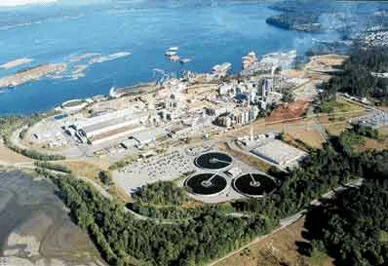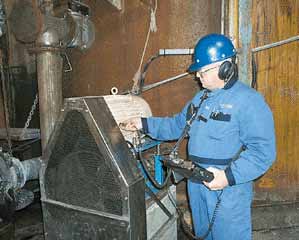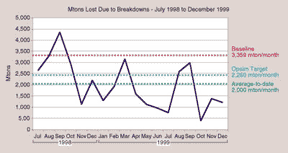The pulp and paper industry in Western Canada is in a period of unprecedented change. Against a background of poor markets, rising costs, aging plants, a shrinking fiber supply, and unceasing pressure from owners to improve returns, managers are being forced to take actions that could not have been contemplated as little as a decade ago.
This article describes the situation at Fletcher Challenge Canada Ltd.’s Crofton, B.C., pulp mill, and the actions taken to increase production by implementation of a cost effective preventive maintenance (PM) program. To be successful, this change required levels of accountability and discipline with which the employees were unfamiliar, and an important part of the implementation process was to build a commitment to the inspection process through involvement and introduction to a culture of continuous improvement.
MILL BACKGROUND. The Crofton mill was built in 1957, with expansions in the early 1960s and 1980s. These expansions included a new pulping line and the construction of three newsprint machines. Under the ownership of British Columbia Forest Products (BCFP), the mill, in conjunction with BCFP sawmills in the area, operated as a fully integrated forest enterprise.
Fletcher Challenge Canada Ltd. was formed in 1988 when Fletcher Challenge Ltd. purchased controlling interest in BCFP. BCFP owned Crofton pulp and paper, Mackenzie, B.C., pulp, and a number of sawmills and forest interests. During the late 1980s and early 1990s, the sawmill and forest interests where sold off as FCCL concentrated on the pulp and paper business.
Crofton Pulp is one-half of FCCL’s operations. Today, the Crofton pulp mill is a two-line kraft mill producing 1,060 mtpd of northern bleached sulfite kraft (NBSK) pulp, of which 150 mtons are used for paper production. The operation is a closed union shop and the B.C. labor laws have, and still do, provide considerable security for the union.
During Crofton’s early years, the earnings from all operations provided a high return, and, to protect the operation in the face of considerable union pressure, many restrictive work practices were accepted by the management of the time. Also, union contracts were very lucrative, with employees being paid much higher wages than those in similar occupations outside the industry. Most employees felt that their employment was secure until retirement.
In the last three decades, however, the industry has become increasingly subject to the effects of business cycles, and it has become increasingly apparent that the habits of the past cannot continue. In addition to cyclic pressures, there are long-term changes to the business environment that have made change inevitable–the most significant being product price. In recent years, the selling price of kraft pulp has maintained a low level. There are also negative pressures on demand for NBSK resulting from new papermaking technology, and the supply of alternative, low cost products has rapidly expanded.
While the above factors impact the whole industry, B.C. faces its own unique challenges. These include aging mills, unusually inefficient work practices supported by labor legislation, increasingly restrictive forest legislation, high property taxes, strong local environmental pressures on logging operations, and increasing competition for available fiber. The end result for the Crofton mill has been poor financial performance and great concern for the future of the enterprise.

Fletcher Challenge Canada’s Crofton, B.C., pulp mill is a two-line kraft mill producing 1,060 mtpd of NBSK pulp, of which 150 mtons are used for paper production.

Millwright George Baird examines a motor as part of a walking inspection route.
CORPORATE REACTION TO THE ECONOMY. In 1995, it became clear to FCCL that the traditional, conservative approach to mill management would be unable to achieve the results required to maintain investor confidence. Because of this, many changes were made, including the division of the company into separate and independent pulp and paper companies. The pulp company “Pulpco” now includes the kraft operations at three of FCCL’s B.C. mills–Crofton, Elk Falls and Mackenzie. Also, management of the three pulp mills was consolidated.
In addition, FCCL’s Pulpco changed from an engineering/operations focus to a business/performance focus. It also moved from a centralized organization to an operating-team-based mill organization, including the elimination of the central maintenance department. A totally new management team was placed, and there was increased accountability for meeting established and measured performance targets.
Other changes included staff reductions and hourly work force reductions. There were also strong efforts made to reduce restrictions permitted under the old labor agreement, culminating in a nine-month strike. However, flexible work practices were introduced, and changes were made to traditional crew responsibilities, as well as to lines of progression.
FCCL’s Pulpco also replaced its computerized maintenance management system (CMMS) and outsourced its materials management to the paper company side of the business. In addition, it began a major project to identify and pursue operational improvement opportunities known as Opsim (OPerationS IMprovement).
The changes were made over a short time period, which resulted in considerable unrest and feelings of insecurity by all employees. While the changes are showing positive results, probably as the result of a very strong and clear message that survival is at stake, there have been some negative effects, including:
- Placement of staff in positions where their skills do not necessarily match the requirements of the job
- Loss of many good systems (for example, the lubrication program and procedure manuals)
- Acute limitations on some resources required to advance the change process
The impact of these effects is being minimized through strong efforts to communicate the state of the business and the progress of improvement initiatives, and through similarly strong efforts to gain commitment of the work force to support the change process.
PREVENTIVE MAINTENANCE OPPORTUNITY. It has long been recognized that the Crofton kraft mill did not operate as reliably as it could, and that this was causing a considerable loss of production. However, no concerted effort had been made to quantify the loss.
During the 1997-1998 strike, the Opsim project was started, with carefully selected teams of people from all three mills assigned to investigate various aspects of each mill’s operation. One of these was Crofton’s “output” team, which studied opportunities to increase mill throughput.
An invaluable tool for this process was the detailed information collected in the mill’s production-loss reporting system, which had been in use for about 18 months prior to the start of the strike. The data for this reporting system is collected and entered by the operating shift foremen, and in the 1996-1997 base year, 5,000 entries were made, with each entry recording the cause of the loss and current mill operating details (grades, etc.) at the time of the loss.
Analysis of the production loss data for the base year showed clearly that the single largest opportunity for improvement was in increased equipment uptime, and that relatively few items of equipment contributed to most of the production losses. Of the 5,000 entries, over 900 reported losses from 400 equipment breakdowns (many resulted in more than one entry because they affected more than one area or lasted longer than one shift). The total production lost due to breakdowns was 32,000 mtons, or about 10% of the mill’s capacity. In addition, further analysis showed that only 87 breakdown events caused 80% of these losses.
ACTION PLAN FOR REDUCING BREAKDOWNS. A small implementation team was established to define the loss reduction goal and to develop an action plan to address the problem of breakdowns. The goal was defined as “implement an improved PM system to save $3.54 MM per year by July 1999.” This represented a 30% reduction in losses from the base year.
This team started work at about the same time as the Crofton mill resumed operation after the strike (April 1998), and it quickly became apparent that mill startup and operating priorities were threatening achievement of the team’s goal. Three immediate actions were then initiated:
- Create a new, full-time position of maintenance systems specialist, with the dual roles of managing the PM process and administering the new CMMS
- Select and retain a consultant to provide guidance and resources for PM implementation
- Select a team of hourly employees to build the new PM process under the guidance of the maintenance systems specialist and the consultant
Howard Turner, a maintenance foreman with past experience as a millwright, machinist, and also as a management trainer, was eventually selected for the new position of maintenance systems specialist. In addition, a team of hourly tradesmen and first-line supervisors was established to choose a consultant, resulting in the selection of IDCON.
A posting for the hourly employees needed to work with the maintenance systems specialist resulted in eight applications from various trades. All applicants were selected and trained, with the understanding that only three would be released to work on the project at any one time. Since no operators or electricians had applied, suitable candidates were approached and they volunteered to work with the team.
To increase the team’s mechanical expertise, two millwrights who were on sick leave were approached and agreed to assist. Both became core team members and brought with them essential computer and inspection skills. One of these millwrights developed a new Microsoft Access database, now known as RoutePro, for all inspections, avoiding the need to purchase a separate system. Unfortunately, the new CMMS did not have the capability of producing good inspection route sheets, but it generated the work orders to initiate inspections.
DESCRIPTION OF THE NEW PM SYSTEM. A comprehensive PM system had been in use for some time, but the repetitive tasks were largely inspections and component replacements requiring plant shutdowns. With the elimination of the central maintenance department, reduction of staff and hourly employees, introduction of a new CMMS, and many people working in areas that they were unfamiliar with, many of the components in the old PM system were lost. There was also a vibration measuring and analysis program, with one technician, supported to varying extents by area millwrights. This system was not lost, but, because of manpower restrictions, it became reactionary rather than proactive.
The initial intent of the implementation team was to extend and formalize the existing PM system and to balance the PM workload to the available manpower. However, after initial discussions and training from IDCON, the team agreed that the emphasis should change from shutdown inspections to a program of ongoing equipment care and monitoring, using the principles of IDCON’s “Preventive Maintenance/ Essential Care and Condition Monitoring” process.
To achieve the greatest benefits in the shortest time, inspections of the “top 87” items of equipment were the first to be implemented. The key components of the new process are:
- inspection routes set up to minimize walking time
- four monthly routes for each area team
- generic equipment component inspections
- condition monitoring standards
- automatic worker order generation system in the CMMS
- reporting process to track adherence to the inspection schedule and for follow-up on corrective maintenance work orders that originate from PM inspections
The maintenance systems specialist also took the initiative to rebuild critical lost systems, such as the lubrication and filter replacement programs. A new lubrication system, Lube-it, is now in use and is certainly contributing to the reliability improvements to date.

FIGURE 1: Results to date from the preventive maintenance program at Fletcher Challenge, Canada’s Crofton pulp operations.
IMPLEMENTATION OF THE PM PROJECT. The implementation process started with a visit from Crofton’s consultant, who reviewed the goals and objectives for the mill’s PM program and developed action plans to achieve them. This visit gave the consultant a chance to view the situation first hand, to meet the people that would be involved, and to take equipment photos that would be use to customize the training session.
Next, the mill posted for PM implementation team involvement from hourly employees and directly asked others, such as operators, in order to get a fully cross-functional team. This was followed by a four day training session for the team and maintenance systems specialist.
During training, half the time was spent in the classroom and the other half was spent in the field doing what had been taught. This session not only covered the tools and techniques used to perform the inspections, but why the inspections were necessary and what the benefits were from doing them. In the field, the PM team and consultant created standard inspections for some of the equipment on the mill’s critical list, which was made up of the 87 items that caused 80% of the production losses.
The PM team’s next step was to divide up all mill production equipment into the three operating team areas, starting with the cooking area, since it was the location of the Crofton mill’s biggest losses. The first route developed was the critical equipment (as defined by production losses due to equipment breakdown) for the cooking area organized into a walking route. While walking the route, the team noted each component in the order it came upon it, designating the component, for example, as motor -AC, coupling-Falk, pump-centrifugal, etc. In total, the team noted 77 standard components mill wide. With the help of IDCON’s database, the team developed a list of standard inspections for each component.
Each of the three operating team areas was further divided into four geographical areas. The equipment in each area would become a monthly route, with one route done each week. Every piece of production equipment would be inspected in detail once a month by the PM inspector. The team also developed four less detailed routes for the field operators. Because they work four days on/four days off, they would perform one route on each day of their tour. Each piece of equipment would be checked by operators every two days.
The team also developed a detailed Condition Monitoring Standard Document for each of the 77 standard components. This is a plastic covered reference document that explains in detail how the equipment works and how to perform the inspections– complete with pictures and reference points. The document also identified any safety or related information that the inspectors might require. In addition, it was used as a training aid for new inspectors.
PERFORMANCE TRACKING. Overall performance is measured simply as a reduction in the cost of breakdown-related downtime as compared to the base year. A fixed contribution per mtons of production is assumed for this calculation, so the results are directly related to the reduction in lost tonnage.
Initially, a derived performance improvement measurement based on the number of inspections completed and the anticipated reduction in annual losses was used, but this number gave rise to too much subjective interpretation.
Individual team performance is measured by compliance reporting of percentage completion of PM inspections as reported on the mill’s CMMS. The team is in the process of development of PM key performance indicators (KPIs) for each maintenance leader. Progress on the PM program, as with all Opsim projects, is reported to the mill manager each month.
PROJECT RESULTS AND FUTURE PLANS. While the project was to be finished July 30, 1999, and good results have been achieved to date, there are still some outstanding activities and issues that require special effort. By accomplishing these, the mill hopes to start along the path towards a culture of continuous improvement.
The Crofton pulp mill is seeing positive changes in plant availability, and while the PM project can not take all the credit for this, it is definitely contributing to the improvement process. The PM project’s goal of 30% reduction in lost production due to equipment breakdown (11,000 mtpy) has been reached (Figure 1). Benefits gained will be maintained through a process of measurement and reporting, and through recognition and rewards for improved plant reliability.
Some of the outstanding issues include final balancing of manpower availability and inspection frequencies, as well as completion of inspection routes–especially piping, electrical, instrument, and operator check lists. Improved alignment and balancing standards, expansion of best operating practices, and completion of development for PM KPIs are also targeted. The mill wants to develop detailed rebuild procedures, installation procedures, and a process for root cause analysis.
In addition, the Crofton mill plans to continue working with the operating team leaders to establish the PM inspections as mandatory routines. There are plans to integrate the PM inspection program with other related activities, such as planning and scheduling, vibration analysis, loss prevention (incident investigation and follow-up), and other inspection programs. Eventually, all responsibilities of the PM implementation team (including performance reporting) will be transferred to the area operating teams.
Howard Turner worked for Fletcher Challenge (now Norske Skog) at the time this article was written. Don Armstrong is still with Norske Skog. Howard is now a consultant with IDCON, Inc.
Consider IDCON’s Preventive Maintenance Manual and/or our Condition Monitoring Standards




